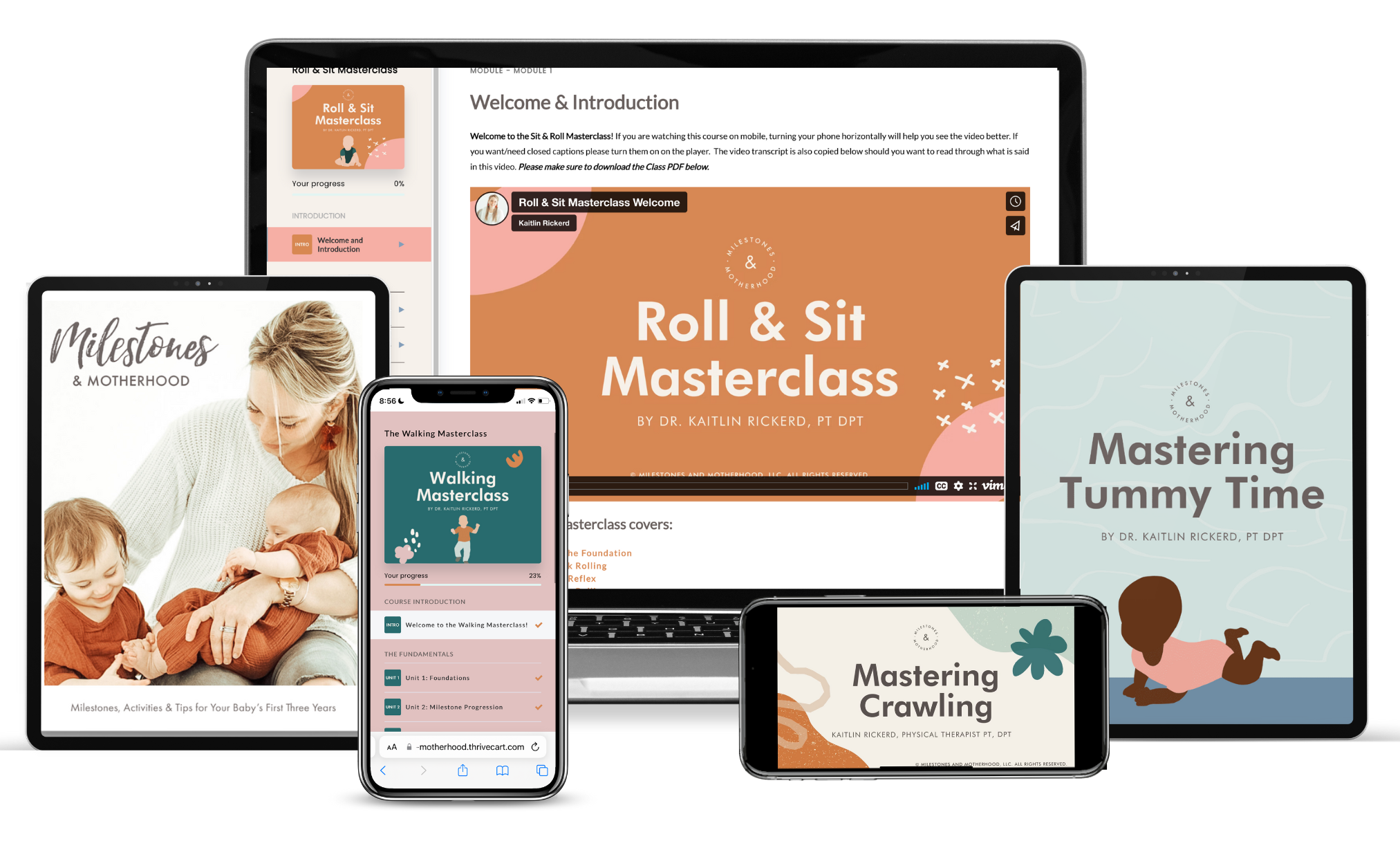The Importance of Crawling
“I never crawled and I’m fine!”
“My little one wants to skip right to walking!”
“I heard crawling isn’t even a milestone…”
I know many of us have heard or even said one or more of these before. I know it’s easy to get defensive if you or your child didn’t crawl. While it’s not the end all be all if your little one skips or modifies it, I definitely stand behind the stance that crawling on hands & knees is SO important for so many reasons! It is a milestone, & an important one!
BUT, Before I say anything else, I want you to know that if your child didn’t crawl, PLEASE don’t panic. The info I’m sharing is applicable to some, but not all. There are always outliers, and while it’s an important milestone, in my opinion, as well as according to the AAP (who recommends screening for crawling at the 9 month well visit), please know there are plenty of adults in the world functioning just fine that didn’t crawl as infants.
Why Is It So Important?
From a motor perspective, some evidence suggests that crawling on hands and knees can impact so much when it comes to development in a positive way! And while ANY movement is so exciting to see from our little ones, hands and knees crawling is absolutely unmatched when it comes to the developmental benefits:
connection & coordination between both sides of the brain. Ex: dressing, reading, sports, riding a bike, basically any time both sides of the brain are working together!
spatial skills & awareness (the ability to locate an object in 3 dimensions by touch and sight)
overall cognitive skills
memory retention
environment awareness
hands, shoulders, hips & core strength
integration of multiple body systems & senses
motor planning
mastery of handwriting, & improved legibility
Crawling is more than just a mode of movement – it's a comprehensive exercise that engages multiple muscle groups, fosters coordination, strengthens core muscles, enhances spatial awareness AND MORE! It helps set the stage for fine motor skills, hand-eye coordination, and even language development as well, SO cool, right?!
Simply put, crawling is such an exciting stepping stone towards supporting your child's future achievements!
But here’s the other thing, there are TONS of perfectly fine adults, stellar athletes & geniuses that didn’t crawl.
Do we want to encourage it? Absolutely! Is it the end of the world if our baby has other ideas? No way!
How You Can Help!
Let’s talk crawling progressions!
Once your little one is up on hands and knees and on the move, or even if they’re army crawling, these are some fun little ways to challenge their muscles that much more.
Use pillows and blankets! Throw them down or completely form a circle on the floor around them so they have to crawl over them to get to a toy they want. You’d be amazed how challenging this can be for them, so don’t be afraid to give them a little help and lots of excited cheers!
Your legs! They’re the best obstacle you never thought of, haha! Put them in between your legs and encourage them to crawl up and over them. This is also a great way to encourage hands and knees, and even to work on sitting to hands and knees transitions if they’re not yet doing that.
More than anything, have fun! You have the tools to help your baby develop and master these skills, and it is so much more fun when you throw the stress away!
Here is a list of some of my favorite toys that I use to help promote crawling too, but seriously, using what you have like mentioned above, works all the same too!
What actually ‘defines’ crawling?
This is definitely a FAQ, and I get it! It can be confusing, especially with conflicting information, so let’s clear it up!
Generally speaking, crawling on hands and knees is considered the ‘gold standard’ we are aiming for, as it truly shows that a child has developed the immense strength, coordination and mobility in BIG important muscle groups to achieve it.
While variations like army crawling, butt scooting, or hitch/3 legged/asymmetrical crawling might seem common (and/or may be present right along side hands and knees at times), if they are the ONLY way your child can crawl, we definitely want to be sure there isn’t anything underlying contributing to that variation that can may actually impact overall development.
Sometimes, it may be as simple as a child starting to army crawling because they are MOTIVATED and want to GO, but don’t quite have the strength & coordination yet to get on hands and knees, and that’s okay! While army crawling doesn’t HAVE to be present, it is often a stepping stone towards hands and knees, with children making the transition within a month or two (ideally!). Sometimes, it may be a bit more contributing to variations like butt scooting and 3 legged crawling - possibly some tightness, weakness, or asymmetrical strength. Again, if those variations are the ONLY way they can navigate their environment independently, ultimately uncovering the WHY can be a game changer AND often relatively easy to do with the right supports….aka, We’ve GOT YOU!
Here is another blog that give some more information about army crawling if that is what your baby is currently doing, and my crawling class could be just what your baby needs to get past army crawling and onto hands and knees crawling!
What About 3-Legged Crawling?
Let’s talk about the 3-LEGGED CRAWL. Basically it’s when one leg is out to the side in a kickstand position.
Why do we want to address it?
In the first few years of life, we want to see SYMMETRY in movement & development. Meaning what is happening on one side of the body, we want happening on the other. This includes hand use, rolling, transitions in/out of sitting, crawling, etc. This is because one side of the brain controls the motor function on the opposite side of the body (except the cerebellum but that doesn’t matter right this second). So when they’re using both sides, they are creating the communication between both sides of the brain equally.
This asymmetry, if not addressed, can change the way some muscles are working, which can lead to differences in strength, some muscles shortening up, and even more not so great habits.
Again, does this mean your child is doomed if they didn’t crawl? Nope. Set that environment up & have some fun with crawling play!
Remember you can ALWAYS take your child back down and practice crawling! Play tunnels, build forts to crawl through, play animal games (pretend to be a dog or bear, whatever!), crawl up a slide or stairs - even if they don’t use it as their primary means of mobility, you can still get similar benefits!
Also, if your baby is just starting to be mobile or is getting close, encourage hands & knees when you can! Always speak with your doctor about any concerns.
For way more in depth info on this, troubleshooting, tips on environment set up & how to encourage crawling, check out my CRAWLING MASTERCLASS!
Want more?
For developmental questions, tips and guidance related to milestones about tummy time, rolling & sitting, crawling and walking, check out KC’s developmental Masterclasses linked here.
Was this helpful? Save it for later!
KC is a pediatric doctor of physical therapy, wife and mom of three! She has spent her career working with children and young adults of all ability levels, and currently specializes in birth to three years.






